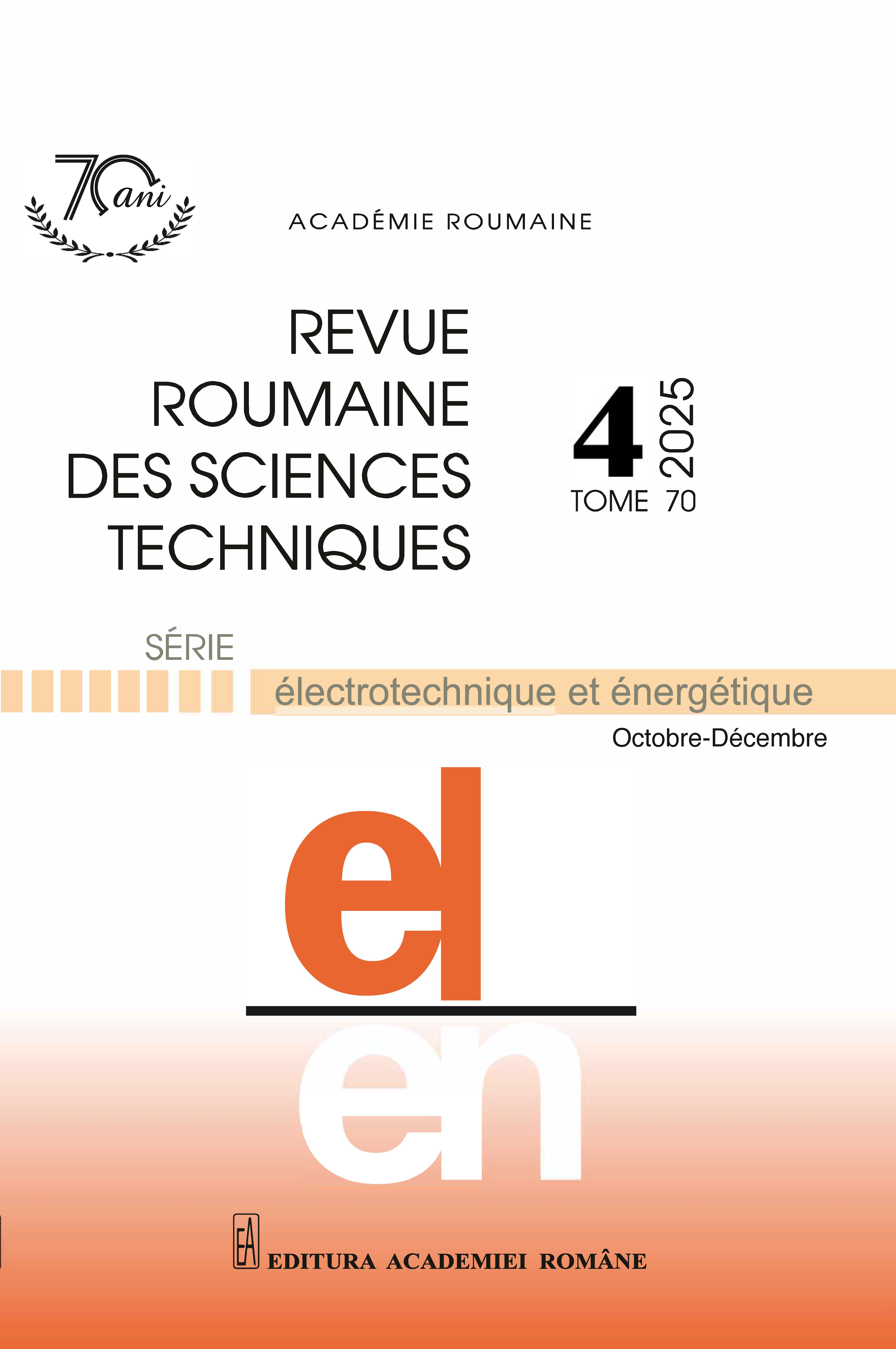EFFECT OF DEFECT GEOMETRY IN A COMPOSITE ON RELIABILITY
DOI:
https://doi.org/10.59277/RRST-EE.2025.4.7Keywords:
Random geometry and Property, Composite, Non-destructive testing, Stochastic finite elements, Reliability analysisAbstract
This work focuses on the study of the effect of the physical properties of a random-type composite material and the geometric shape of defects on the reliability analysis of an inspection device using non-destructive testing. Two types of defect geometries are considered: rectangular and triangular. A stochastic finite element method (SFEM) was used to solve the 2D electromagnetic equation in a cylindrical structure. The differential sensor recovers the impedance change signal in the fault zone. The signal is analyzed and compared for the two types of geometries. Post-processing is started to assess the reliability of our structure by determining the reliability index and the probability of failure. The results obtained for random rectangular and triangular shapes are presented, along with a comparison between the stochastic finite element method and the Monte Carlo method. A good agreement is observed. The results show that the proposed SFEM model offers post-processing in addition to analysis, compared to the Monte Carlo method, which requires numerous draws for analysis and relies on the inverse problem to determine the actual values of the physical property considered.
References
(1) D. Kumar, R. Durgesh, C. Pruncu, Recent progress of reinforcement materials: a comprehensive overview of composite materials, J. Mater. Res. Technol., 8, 6, pp. 6354–6374 (2019).
(2) D. Kumar, S.D. Abdul Kalam, Design, analysis, and comparison between the conventional materials with composite material of the leaf, springs, Fluid Mech. Open Access, 3, pp. 127 (2016).
(3) J. Wen, Y. Zeng, C. Wu, J. Guan, H. Guo, Silk lattice structures from unidirectional silk fiber–reinforced composites for breaking energy absorption, Adv. Eng. Mater, 22, pp. 190092 (2020).
(4) D. Ragul, V. Thiyagrajan, A novel fault-tolerant asymmetrical 21-level inverter topology with reduced components, Rev. Roum. Sci. Techn. – Électrotechn. et Énerg., 68, 2, pp. 200–205 (2023).
(5) H.K. Bui, G. Wasselynck, D. Trichet, G. Berthiau, Application of degenerated hexahedral Whitney elements in the modeling of NDT induction thermography of laminated CFRP composite, IEEE Trans. Magn., 52, 3 (2016).
(6) M. Bowkett, K. Thanapalan, Comparative analysis of failure detection methods of composite materials, systems, Syst. Sci. Control Eng., 5, pp. 168–177 (2017).
(7) K. Guerraiche, A.B. Abbou, L. Dekhici, Intelligent fault detection and location in electrical high-voltage transmission lines, Rev. Roum. Sci. Techn. – Série Électrotechn. et Énerg., 69, 3, pp. 269–276 (2024).
(8) Z. Oudni, A. Berkache, H. Mehaddene, H. Mohellebi, J. Lee, Comparative study to assess reliability in the presence of two geometric defect shapes for non-destructive testing, Przegląd Elektrotechniczny, 95, 12, pp. 48–52 (2019).
(9) J. García-Martín, J. Gómez-Gil, E. Vázquez-Sánchez, Non-destructive techniques based on eddy current testing, Sensors, 11, pp. 2525–2565 (2011).
(10) G. Wasselynck, D. Trichet, J. Fouladgar, Determination of the electrical conductivity tensor of a CFRP composite using a 3-D percolation model, IEEE Trans. Magn., 49, 5 (2013).
(11) D. Hachi, N. Benhadda, B. Helifa, I.K. Lefkaier, B. Abdelhadi, Composite material characterization using eddy current by 3D FEM associated with iterative technique, Adv. Electromagn., 8, 1 (2019).
(12) T. Takagi, M. Hashimoto, H. Fukutomi, K. Miya, H. Tsuboi, M. Tanaka, J. Tani, T. Serizawa, Y. Harada, E. Okano, R. Murakami, Benchmark models of eddy current testing for steam generator tube: experiment and numerical analysis, Int. J. Appl. Electromagn. Mater., 5, pp. 149–162 (1994).
(13) Z. Oudni, M. Féliachi, H. Mohellebi, Assessment of the probability of failure for EC nondestructive testing based on intrusive spectral stochastic finite element method, Eur. Phys. J. Appl. Phys., 66, 3, pp. 30904 (2014).
(14) Z. Oudni, T. Mahmoudi, Exploitation of the spectral stochastic finite element model for the evaluation of surface defects of the CFRP composite, Prog. Electromagn. Res. M., 127, pp. 75–83 (2024).
(15) T. Mahmoudi, Z. Oudni, A. Berkache, J. Lee, Characterization of defects in composite materials by the intrusive stochastic method using the Gaussian type random variable, Przegląd Elektrotechniczny, 99, 3, pp. 246 (2023).
(16) S. Makkapati, S. Ramalingam, Lifetime prediction of single-stage LED driver circuit using Bayesian belief network, Rev. Roum. Sci. Techn. – Électrotechn. Et Énerg., 68, 4, pp. 351–356 (2023).
(17) B. Ponnuswamy, C. Columbus, S.R. Lakshmi, J. Chithambaram, Wind turbine fault modeling and classification using cuckoo-optimized modular neural networks, Rev. Roum. Sci. Techn. – Électrotechn. Et Énerg., 68, 4, pp. 369–374 (2023).
(18) M. Khebbab, M. Feliachi, E.H. Latreche, Application of finite elements heterogeneous multi-scale method to eddy currents non-destructive testing of carbon composite material, Eur. Phys. J. Appl. Phys., 80, pp. 10401 (2018).
(19) Y. Mizutani, A. Todoroki, Y. Suzuki, K. Mizukami, Detection of in-plane and out-of-plane fiber waviness in unidirectional carbon fiber reinforced composites using eddy current testing, Composites Part B, 86, pp. 84–94 (2016).
(20) M. Berveiller, B. Sudret, M. Lemaire, Stochastic finite element: a non-intrusive approach by regression, Eur. J. Comput. Mech., 15, 1-2-3, pp. 81–92 (2006).
(21) A. Efremov, O. Karpenko, L. Udpa, Generalized multifrequency fusion algorithm for defect detection in eddy current inspection data, NDT & E Int., 129, 3, pp. 102654 (2022).
(22) S. Pranesh, D. Ghosh, A FETI-DP-based parallel hybrid stochastic finite element method for large stochastic systems, Comput. Struct., 195 (2018).
(23) M. Loeve, Probability theory I, Springer-Verlag Inc. (1977).
(24) C.R.A. Da Silva Jr., A.T. Beck, E. Da Rosa, Solution of the stochastic beam bending problem by Galerkin method and the Askey-Wiener scheme, Latin Am. J. Solids Struct., 6, pp. 51–72 (2009).
Downloads
Published
Issue
Section
License
Copyright (c) 2025 REVUE ROUMAINE DES SCIENCES TECHNIQUES — SÉRIE ÉLECTROTECHNIQUE ET ÉNERGÉTIQUE

This work is licensed under a Creative Commons Attribution-NonCommercial-NoDerivatives 4.0 International License.


